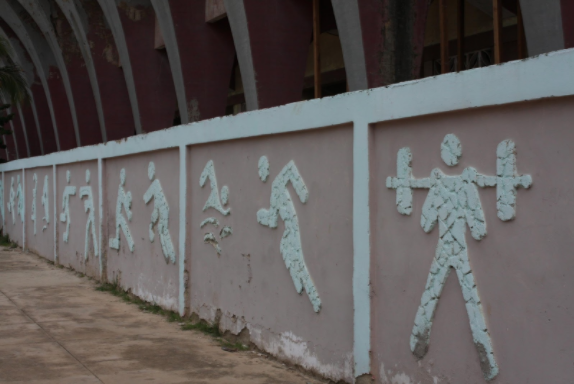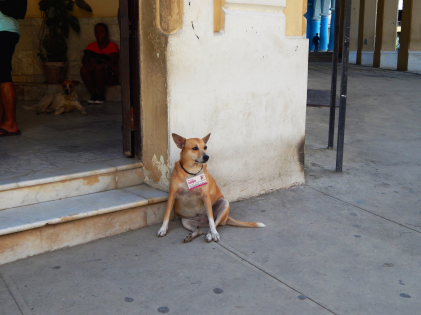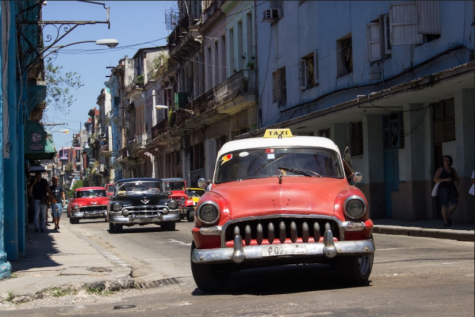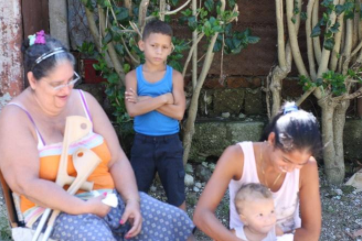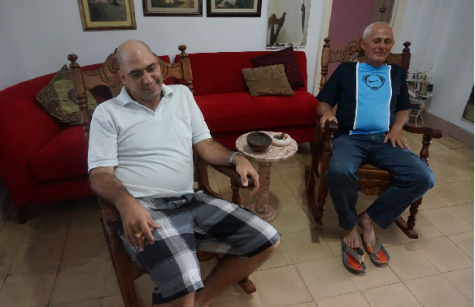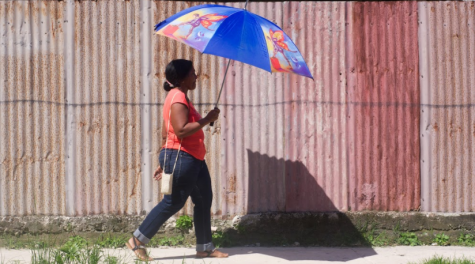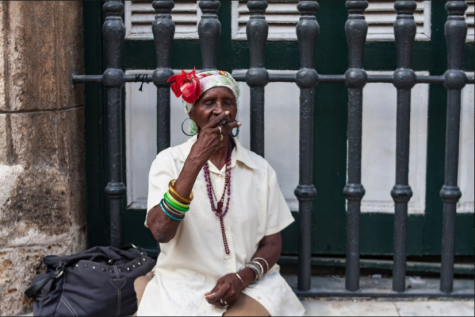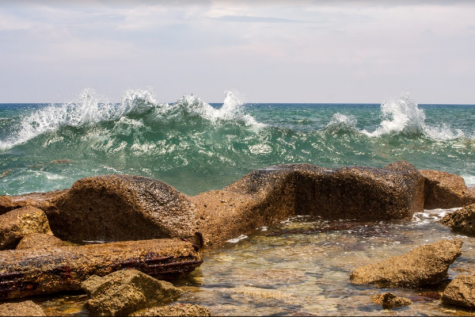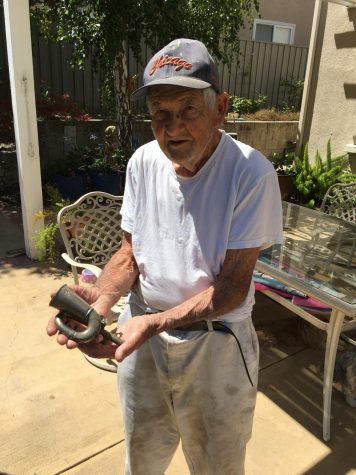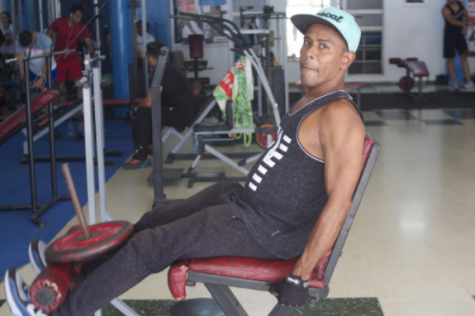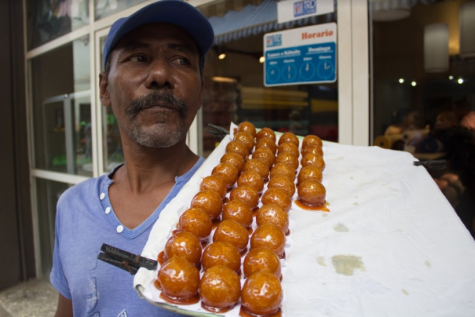Cuban fitness, an evolving culture
August 28, 2017
It is a hot and humid afternoon in Havana, Cuba. The Spanish spoken around by the locals is foreign and different to me, but while walking by a nearby house, I recognize a familiar sound: the clanging and banging of weights and the grunting of men and women.
Behind a locked chain link fence, I see a familiar sight. Men and women are lifting weights and working out in a backyard area the size of a small apartment. A sign above the workout area read “gimanasio.”
In the distance, a muscular man wearing a tight Under Armour shirt is moving with a purpose. His occupation is as obvious as the smell of sweat in the gym. He must be a trainer or at least someone who works here.
“My name is Alejandro, this is my gym,” the man says. Not only is he the owner of the gym, but he is also a personal trainer, gym janitor, and equipment handyman.
Like many people in Cuba, Alejandro is part of the growing population of entrepreneurs on the island looking to start their own businesses since the easing of restriction on private businesses by the communist government. Alejandro’s gym is still in its infancy, as it only opened four years ago in his front yard as a way to make money and to pursue his passion.
“In Cuba we have to build or custom order all the equipment,” Alejandro says, since they are not readily available or cheap, especially on an island where the average person makes the equivalent of 25 USD a month.
Although all the machines and equipment were custom made from spare materials, they were still recognizable and performed the same functions as the machines and equipment back in the United States.
Bench press stations, cable pulleys, pull-up bars, hack squat machine, leg presses, dumbbells, barbells and other exercise machines are some of the equipment that can be found at most gyms in Cuba.
Cardio equipment in is harder to find in Cuba. The majority of cardio machines found here are stationary bikes, in addition to a few elliptical and stair climber machines. Treadmills are almost non-existent. The reason for this could have to do with the majority of the population having to use walking as the main mode of transportation.
Alejandro provided me with a list of other gyms in the area. About a 10-minute walk from his gym, another destination was near but the location was unclear. In that moment two people walked by wearing workout gear and carrying gym bags.
Unaware if these people were headed to the gym or heading home, I go out on a limb and follow them for two blocks, down some stairs to the basement of a building and what do you know, it’s the gym!
A common theme in all the gyms in Cuba is that they are all hidden with very little signage. Most of them were in the basements of larger buildings or down dark alleys, places typically associated with drugs and crime, not with barbells and cardio machines.
This is a stark contrast to the U.S., where gyms are highlighted with huge signs and neon lights in the hopes of drawing your attention. The gyms, like every other business in Cuba, are a bit low key and often times have only a small sign that could be missed if you take too long to blink.
And yet, “Exercise is big in Cuba….any gym in the country will be full in the morning before work and in the evening after work,” says Victor, a fitness enthusiast at a local gym. When asked about the demographics of people that come to the gym and for what reasons, he responds, “Men and women both like to exercise…first for their health and second for their looks (depending on who you talk to)….older people work out too, but it is mostly younger people who come to the gym.”
When asked how he knows what to do at the gym, such as specific exercises, reps, sets, etc., Victor says he gets workout plans and information from two sources: the personal trainers at his gym and the Internet.
All people that are members of Victor’s gym are required to meet with a personal trainer before they start using the facility. They orientate the new members on what all the machines and equipment do and how to use them.
Additionally, they provide the new member with a sample workout plan that ensures they work out every muscle; whether they follow this plan is up to them.
Lastly, the personal trainers briefly talk to them about nutrition, which Victor says is pretty simple: “Eat natural foods…not fast food.”
Specific exercise programs and nutritional counseling can be made available to them if they schedule and pay for individual sessions, but if they have any questions they can always ask any personal trainer at the gym.
The fitness culture within Cuba is not limited to the gyms of the country. Other areas are also associated with different aspects of fitness and physical activity.
Throughout the city of Havana, there are recreational areas like grass fields, basketball courts, baseball fields and jungle gyms, and metal workout machines are also scattered around different neighborhoods.
The number of these recreational places in such a small area shows how much physical activity, sports and fitness is valued in a country where social welfare programs and the population’s well-being is valued.
Besides free healthcare and education for its population, Cuba also gives its citizens a ration booklet. This book provides every person in Cuba with a basic amount of food and supplies per month.
Everyone is guaranteed a certain amount of rice, beans, eggs and cooking oil per month. While this alone is not enough for Cubans to survive for a whole month, it does help, and life without it would be impossible.
Recently Raul Castro, the leader of Cuba, proposed eliminating the ration book due to its large cost, but he was met with overwhelming opposition. This system has affected not only regular Cubans’ nutrition habits, but also the nutrition options available to people involved within the fitness community.
There are four places to get your food in Cuba: farmer’s markets and grocery stores, both state run and private. The most obvious difference between the state-run markets and the private markets is that the state-run markets always have fewer products and longer lines.
Products in the state-run businesses are cheaper, but they have less variety of goods and ran out of things faster. Prices are fixed at these state-run markets, thanks to government subsidies. This makes food products cheaper for the population by reducing the cost to a fraction of their market value retail price.
Private markets have more availability and variety. Lines are also much shorter at these private markets, but prices are also higher.
Due to this price discrepancy and the variety of food available, the average Cuban diet can vary widely depending on how much money they make and what is in stock. This means nutrition related to the fitness culture is often troublesome.
“Nutrition in Cuba is tough…particularly for protein. Meats and fish are expensive, but eggs and beans are easy to get,” Victor said.
This is a reoccurring theme that keeps coming up as I talk to more Cubans. The nutritional knowledge is there, but the supply and monetary means to follow this nutritional knowledge is another story.
As in the United States, nutritional supplements are becoming popular in the emerging fitness culture on the island of Cuba. While talking to Alejandro at his gym, he disappears into a side room and reappears a few seconds later with a huge grin on his face radiating excitement. In his hand, he has a bottle of whey protein powder with writing in Spanish. His joy can be attributed to the rarity of protein supplements on the island.
He refuses to tell me where he got it from but goes on to say there is a black market for protein and other nutritional supplements in Cuba. This market is composed of products brought in from other countries such as Mexico, Venezuela, European nations, and even the United States.
Products from abroad are sold in Cuba for double or triple their market value. Due to the lack of supply and marked up prices, they are out of reach for most Cubans.
Although a basic knowledge of nutrition exists for both the average gym goer and the fitness professional, the knowledge is learned from a variety of sources. This is due to the fact that in Cuba, no certification is necessary to become a personal trainer or fitness professional.
While some who work in the field have educational experience, most do not. Ole, a personal trainer at a gym, said he learned about nutrition and fitness on the “streets” and other sources, such as body builders, books and the Internet.
Osorio, another personal trainer in Havana, actually went to school for the Cuban equivalent of an exercise science degree. He is a former boxer and bodybuilder and has excellent knowledge regarding nutrition.
His advice for clients and the average gym goers is to “Eat every three hours…vegetables, fruit and natural juices, no fast food. Eat protein with every meal…eggs, burger, chicken breast.”
Osorio is very transparent about his nutritional habits. He says, “In the morning I eat five egg whites, oatmeal and beef burger…three hours later fruit juice (smoothie)…for lunch, fruits and vegetables…then train…after for dinner lots of proteins and vegetables.”
While this seems like a pretty strict diet for anybody, he insists he is not as strict as he once was, since he is older now and done with bodybuilding competitions, but you would not know it by looking at him.
Osorio is about 5 feet 6 inches, about 200 pounds, with not an ounce of fat on him. His shirts are extra-large, but on his body they look like a size small.
Osorio is the poster child for the new Cuban dream. He grew up boxing and bodybuilding, but after the government eased restrictions on private businesses, he was able to open his own gym.
This is extremely important because all the gyms in Havana are privately owned and just opened a few years ago after the government allowed private businesses to operate. Before this, all the fitness equipment and culture were confined to sports teams and their facilities.
As Cuba’s communist government increasingly opens up to the world and embraces a more free market economy, it will be interesting to see how the island and its fitness culture changes. Only time will tell, but the passion and desire for this culture are already vibrant on the island and will only grow stronger as access increases.




